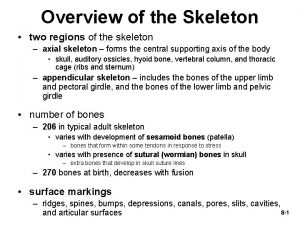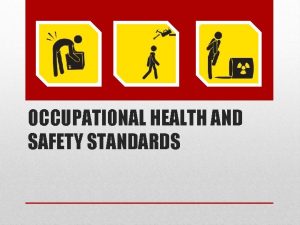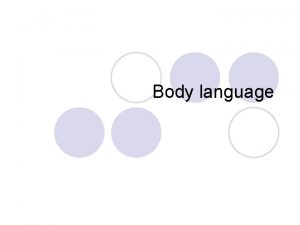FINAL EXAM REVIEW 3 TRUE OR FALSE 1




















































- Slides: 52

FINAL EXAM REVIEW 3 TRUE OR FALSE

1 Ecological footprints tend to be higher in developed countries than they are in developing country.

2 Several of the least expensive ways to achieve a sustainable lifestyle would include employing water conservation, recycling, bicycling, and eating local produce.

3 When using the I=PAT model, population (P) tends to be the most important factor in determining the environmental effects of developing countries, while technology (T) tends to be the most important factor for developed countries.

4 According to our study this year, three major cultural changes (revolutions) have occurred in human history. They are Information-Globalization. . Industrial-Medical. . . and Transportation-Globalization.

5 Both total Fertility Rate and rate of resource consumption tend to be higher in developing countries than developed countries.

6 Reducing overall consumption and halting population growth will lead to a more sustainable world culture.

7 The priority for sustainable use of nonrenewable resources should be recycle…reuse …reduce…refuse.

8 When women have access to education and paid employment outside the home, the total fertility rate decreases.

9 One of the best measures of a society's quality of life is a country’s infant mortality rate.

10 Age structure diagrams that indicate rapidly growing populations have the shape of a pyramid.

11 A high birth rate, low death rate, and an increase in population size are all indicative of the industrial stage of the demographic transition.

12 The current world population is just over 7 billion people.

13 The rule of 70 is a quick way of estimating a population’s growth rate.

14 Plotting exponential growth on a graph would look like J shaped curve.

15 To determine the number of individuals that will be added to a population in a specified time, you should multiply the growth rate by the original population size.

16 The US age structure diagram looks like a pyramid.

17 The total fertility of a society decreases as the society progresses through the demographic transition.

18 The rate at which the population has been growing has slowed in the past 50 years, but the human population is still getting larger

19 In terms of energy flow, energy moves from autotrophs to heterotrophs to decomposers, which convert it into a usable form, which producers use again

20 Top predators are often the most vulnerable to human impact.

21 Humans have dramatically altered the flux rate of nitrogen from soils to the atmosphere

22 The increase in forest fires, tsunamis, and volcanic eruptions th could contribute to a 6 mass extinction in the near future.

23 Vegetarianism is often cited as a partial solution to the growing problem of deforestation and other types of habitat destruction as the human population continue to grow. The reason for this is that more people can be fed using less agricultural land because vegetarians eat at a lower trophic level.

24 “Dead zones” characteristic of the Gulf of Mexico and many other marine locations worldwide most frequently result from a disrupted carbon cycle.

25 NPP is always less than GPP due to internal consumption of glucose.

26 Hunting and fishing are not allowed in national forests.

27 Yosemite National Park was the first national park.

28 When pests are continually exposed to chemical pesticides, they can become resistant due to natural selection.

29 Monoculture planting has led to an increase in the genetic diversity of plant species.

30 Organic farming involves using genetically modified plant varieties that kill insects that feed on them.

31 The major environmental problem arising from feedlots is pollution of surface and groundwater, resulting in eutrophication

32 Wilderness areas allow no roads, no development, no permanent structures, and no recreation

33 Biological controls are frequently used to replace persistent chemical pesticides. A potential risk of using these biological controls is that the control agent attacks not only its intended target but also beneficial species

34 A high Biological oxygen demand a high fecal coliform count is a good indication that a lake was primarily contaminated by human sewage from local septic systems

35 Nitrous oxide and sulfur dioxide are common indoor pollutants.

36 Bisphenol A (BPA), commonly found in plastics, can mimic endocrine disruptors.

37 The biggest threat to sustainable rangelands is overgrazing.

38 Lack of genetic diversity in food crops such as corn can lead to the crop’s increased susceptibility to plant disease.

39 No trees grow in desert biomes.

40 The zone on Earth that extends o o between 30 and 60 latitude is the tropical zone.

41 El Nino plays a key role in influencing regional climate.

42 The Eastern United States is primarily a coniferous forest.

43 Risk assessment quantifies the potential harm that a chemical poses

44 Risk assessment does not include the social, political and economic considerations.

45 Risk assessment always includes lab &/r field experiments focusing on the hazard in question

46 Risk management includes the social, political, and economic considerations

47 Risk management does not consider potential harm that a chemical poses

48 In the United States, about one third of our generated municipal solid waste ends up being recovered in composting in recycling

49 From an environmental waste perspective, the most effective and desirable approach is to recycle.

50 Incineration is a contemporary method of handling municipal solid waste and contributes to decreasing the life of sanitary landfills

 Amer rasheed
Amer rasheed Uncontrollable spending ap gov
Uncontrollable spending ap gov World history spring final exam review answers
World history spring final exam review answers Spanish 1 review packet answer key
Spanish 1 review packet answer key Pltw human body systems final exam
Pltw human body systems final exam Poe final review
Poe final review Ied final exam review
Ied final exam review World history b semester exam review practice
World history b semester exam review practice Entrepreneurship 1 final exam review
Entrepreneurship 1 final exam review Spanish 2 final exam review packet
Spanish 2 final exam review packet Final exam environmental science
Final exam environmental science Ap world history jeopardy review game
Ap world history jeopardy review game Us history final semester 2 review
Us history final semester 2 review English 2 semester exam
English 2 semester exam Physics 20 final exam practice
Physics 20 final exam practice Physical science final exam review
Physical science final exam review Mat1033 final exam
Mat1033 final exam Fe exam statics review
Fe exam statics review Zoology semester 1 exam review answers
Zoology semester 1 exam review answers Earth science final
Earth science final Final exam review algebra 1
Final exam review algebra 1 Hft accounting
Hft accounting Personal finance final exam review
Personal finance final exam review Spanish 2 final exam review
Spanish 2 final exam review Psychology final exam review
Psychology final exam review Slidetodoc.com
Slidetodoc.com Light is electromagnetic wave true or false
Light is electromagnetic wave true or false Most groundwater comes from rain true or false
Most groundwater comes from rain true or false Which of these statements is true?
Which of these statements is true? True vocal folds and false vocal folds
True vocal folds and false vocal folds There are four season all over the world true or false
There are four season all over the world true or false A four-sided polygon.
A four-sided polygon. Percent increase and decrease maze
Percent increase and decrease maze Lumbat
Lumbat Refers
Refers Mla works cited indentation
Mla works cited indentation Boolean operators truth tables
Boolean operators truth tables True or false questions about leadership
True or false questions about leadership Does heat radiation travel in straight lines
Does heat radiation travel in straight lines Identify each statement as either true or false.
Identify each statement as either true or false. Decide whether each statement
Decide whether each statement Chapter 8 telephone techniques
Chapter 8 telephone techniques Accounting chapter 1 true and false
Accounting chapter 1 true and false In block format, all new paragraphs are indented
In block format, all new paragraphs are indented Language
Language Test 11a accounting
Test 11a accounting Luckiest man in the world
Luckiest man in the world Bread is made of wheat true or false
Bread is made of wheat true or false Los pasteles son muy _____ para la salud.
Los pasteles son muy _____ para la salud. Tipe data pada bahasa pascal
Tipe data pada bahasa pascal Bilangan yang mengandung pecahan
Bilangan yang mengandung pecahan True or false science questions
True or false science questions A spider is an insect true or false
A spider is an insect true or false











































































